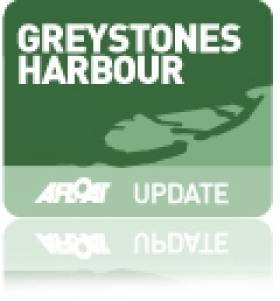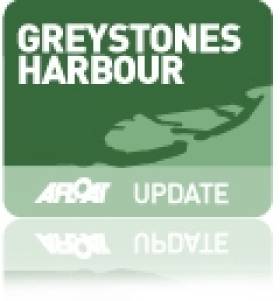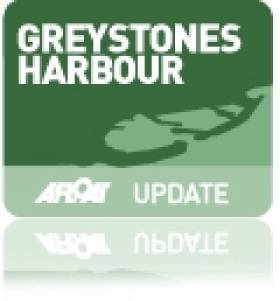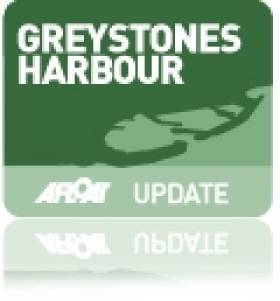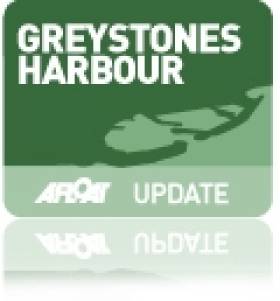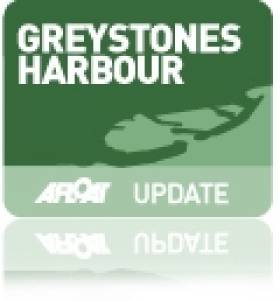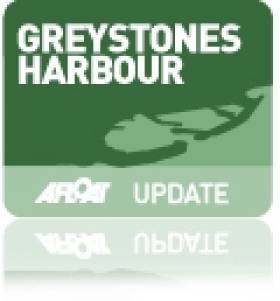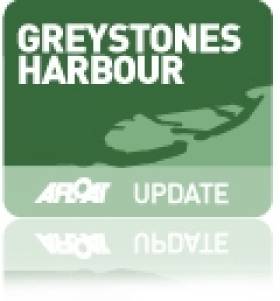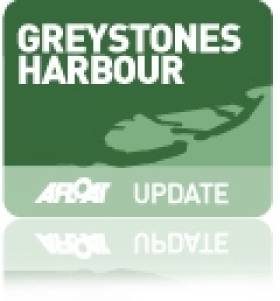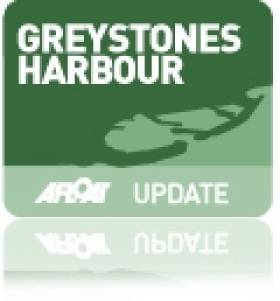Displaying items by tag: Greystones Harbour
Greystones Marina Appoints Alan Corr as Marina Manager
#Greystonesharbour – Alan Corr has been appointed as the new Manager of Greystones Harbour Marina. A keen yachtsman, Corr has over 40 years of professional experience in the marine industry. He played an integral role in the design and development of Dun Laoghaire Marina, acting as Operations Manager across the initial expansion phase.
"My plan is to encourage more visitors and attract sailing bodies such as ISORA to come and start or finish races off Greystones" Corr told Afloat.ie
Corr also said he would be keen to attract one design classes. Boats such as the Flying Fifteen (FF) can benefit with two slipways plus the use of the hoist that is now operating.
1000 Boats Visited Greystones Harbour Marina in First Summer of Opening
#greysyonesharbour – Greystones Harbour Developer Sispar has published an upbeat newsletter in the first weeks of 2014 outlining a growth of visitor numbers to the east coast port in 2013. It's all thanks to the new town marina now operated by BJ Marinas Ltd since last April. Over 1000 boats visited Greystones in County Wicklow over the Summer months according to Sispar and nearly 100 boats and 500 sailors attended the 'Taste of Greystones Regatta' weekend last September.
The town now has a purposes built modern facility at a cost of some €70m as opposed to the 200–year–old harbour wall that was badly silted up, the newsletter says. The benefits are being felt by local business and a Chamber of commerce spokesperson says the marina in only its first season has made a 'great difference'.
There are now 60 dinghies in the sailing club pen, 40 boats in the rowing club and 90 on the marina, according to the latest Sispar figures. It's part of a strategy of making Greystones one of the top three east coast harbours.
The North Pier will open to the public with the access route to be determined by future safety requirements and as Afloat reported previously, a new 30–ton travel hoist allows visiting an resident boats to be lifted for maintenance and repairs.
Greystones Marina to Install Travel Hoist Crane & Boatyard Shortly
#greystonesharbourmarina – As a glorious first summer season comes to an end for Greystones Harbour marina in County Wicklow, the brand new east coast harbour is looking back on some memorable times including a first keelboat regatta for the Wicklow town.
With an overwhelming amount of visiting yachts travelling from neighbouring marinas and clubs as well as European waters, expectations have been exceeded for the 100–berth marina. The new factility played a part in helping Greystones Sailing Club with its first inaugural cruiser regatta. The "Taste of Greystones" had over 70 entries. The atmosphere was fantastic and the marina reception drew a great crowd to join in with the celebrations. The Sailing Club made a great effort and plans are afoot for a second regatta next year.
Now approaching its winter season Greystones Harbour marina is offering winter berthing rates with news too that the marina will shortly be operating a travel hoist crane and boatyard adjacent to the marina.
Greystones Harbour Lecture at National Yacht Club Highlights New East Coast Boating Facility
#greystonesharbour – Last Wednesday night (28th August) in The National Yacht Club, an audience of up to sixty people heard of the origins, design and construction of the new Greystones Harbour, presented by Councillor Derek Mitchell of Wicklow County Council and Sean Mason of Arups.
The event was hosted by the Civil Division of Engineers Ireland in response to a request from members of the DBSC Thursday night racing community who couldn't make the original presentation at the Clyde Road offices of Engineers Ireland.
Councillor Mitchell gave some of the historical and political background to the project and touched on some of the community aspects while Sean Mason dealt with the technical aspects of the design and construction.
The lecture started at 19:35 and finished after 21:00 with the speakers taking up just over an hour. An active Q&A session followed the presentation.
The development of the harbour is a first for the PPP model of investment whereby a combination of public and private investment funds the project. Representatives of the contractor, Sisks, were in the audience and they too contributed to some of the answers that were provided.
The Civil Division would like to thank our hosts for the evening, The National Yacht Club, the speakers, Messrs Mitchell & Mason, the people who came out to listen to the lecture, Afloat magazine and the four Dun Laoghaire yacht clubs who promoted the lecture.
Cormac Bradley
Chairman, Civil Division
Engineers Ireland.
Greystones Motor Yacht Club (GMYC) Hosts RNLI Evening
#Greystonesharbour – Greystones Motor Yacht Club will have an RNLI Lifeboat presentation night next Thursday 29th August at 8pm.
The venue is upstairs at the nearby Beach House Pub, next door to Greystones Harbour, a location popular with visiting sailors, including the Squib class.
Joe Taylor from the RNLI hopes to have the lifeboat 'Annie Blaker' in attendance at the harbour.
GMYC We is also going to launch the new Greystones Harbour defibrillator scheme with an explanation of how it will operate.
Greystones Harbour & How it Was Built Presentation
#greystonesmarina – Ireland's newest marina and harbour in Greystones, Co. Wicklow are the focus of a presentation at Dun Laoghaire's National Yacht Club on Wednesday 28th August. A presentation of the Civil and Maritime Works on the building of the new Greystones Harbour will described from concept stage through to initial operations, covering all stages of design and construction.
The delivery of a significant public amenity through the PPP vehicle is addressed, illustrating the inter-relationships between planning, design and construction. The project included a few 'firsts' and was not without significant challenges, both publicly and technically.
The presentation will be given by Mr. Sean Mason, F.I.E.I. of Arup. Cllr. Derek Mitchell will address the local community aspects of the development process and the impact of the transformation of the old harbour into a vibrant maritime facility. Mr. Mason will address the technical aspects of the development from initial concept stage through to construction completion.
The lecture is at the National Yacht Club, Wednesday 28th August 2013 @ 19:30. A flyer is available to download below.
Video taken on an evening microlight flight over Greystones harbour in County Wicklow reveals progress at the new town marina a month after it opened. A mix of 25 boats from sailing cruisers to motor boats to ribs and speedboats are now berthed at Ireland's newest boating facility.
The video made public on youtube by Gary Fortune was taken on a windless night for sailing and also shows a local Greystones Sailing Club dinghy fleet searching in vain for wind. The 100-berth capacity marina comes into view at about 1 minute 52 seconds on the above timeline.
Greystones Harbour Marina Opens on Easter Monday
#greystonesharbourmarina – The Irish Sea's newest marina opens in Wicklow on Easter Monday. Greystones Harbour Marina will open on 1st April 2013 with 100 berths available initially.
Since arriving on site in December operators BJ Marinas Ltd have been working around the clock to ensure they met their target of being open for the start of the boating season on 1st April.
Managing Director Bernard Gallagher said "We're delighted to be appointed as harbour and marina operators. It's a unique and stunning site and we're looking forward to opening this new marina on Monday'
BJ started taking bookings in late January and have had a steady stream of commitment from berth holders since then.
There will be 100 berths initially ranging from six metres to 30 metres. Once completed there will be 230 berths.
#greystonesharbour – It's full steam ahead at Greystones Harbour where operators BJ Marinas Ltd are putting the final touches to the marina ready for opening in 11 days time on April 1.
Our exclusive photo (taken yesterday) shows recent progress in the marina basin with piling complete and furniture being installed.
BJ, will operate the marina and boatyard, say they are 'really happy with the progress' and confirm the marina will open on schedule.
The pontoon installation will be completed shortly with 100 berths initially and the access bridge should also be complete by the weekend.
Office and facilities will be in place early next week and other services and the access road are also well under way.
Local boaters have already being eyeing up the new facility. Greystones Sailing Club has put together a provisional programme for Keelboat racing this season, a new era for the club.
The County Wicklow marina has received '85 serious enquiries' for berths over the Christmas and New Year Period. Berthing details are here.
The newest addition to boating on Ireland's east coast is operated by BJ Marinas Ltd, a company owned by senior marine industry figure Bernard Gallagher.
The firm are operating the new site under contract from developers Sispar and Wicklow County Council.
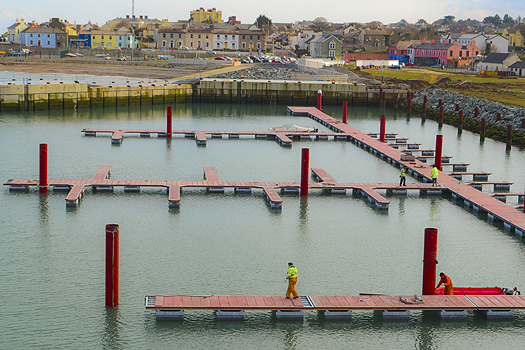
Greystones Harbour Marina takes shape – pontoons are installed this week to give Ireland a new addition to its coastal marina network
#greystonesharbour – With work at Greystones Harbour marina progressing well this month, piling nearly complete and pontoons being floated into position, Greystones Sailing Club has been putting together a provisional programme for Keelboat racing this season.
In an exciting new era for the Club its keelboat captain Mark Usher has invited all keelboat berth holders, and those who intend to apply for a berth, to an open discussion in the Club on Friday 22nd March at 8pm when outline plans for the season ahead will be announced.


























